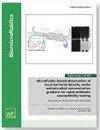Acoustohydrodynamic micromixers: Basic mixing principles, programmable mixing prospectives, and biomedical applications
IF 2.4
4区 工程技术
Q2 BIOCHEMICAL RESEARCH METHODS
引用次数: 0
Abstract
Acoustohydrodynamic micromixers offer excellent mixing efficiency, cost-effectiveness, and flexible controllability compared with conventional micromixers. There are two mechanisms in acoustic micromixers: indirect influence by induced streamlines, exemplified by sharp-edge micromixers, and direct influence by acoustic waves, represented by surface acoustic wave micromixers. The former utilizes sharp-edge structures, while the latter employs acoustic wave action to affect both the fluid and its particles. However, traditional micromixers with acoustic bubbles achieve significant mixing performance and numerous programmable mixing platforms provide excellent solutions with wide applicability. This review offers a comprehensive overview of various micromixers, elucidates their underlying principles, and explores their biomedical applications. In addition, advanced programmable micromixing with impressive versatility, convenience, and ability of cross-scale operations is introduced in detail. We believe this review will benefit the researchers in the biomedical field to know the micromixers and find a suitable micromixing method for their various applications.声流体动力微搅拌器:基本混合原理、可编程混合前景和生物医学应用
与传统微搅拌器相比,声流体动力微搅拌器具有出色的搅拌效率、成本效益和灵活的可控性。声学微搅拌器有两种机制:以锐边微搅拌器为例,通过诱导流线产生间接影响;以表面声波微搅拌器为例,通过声波产生直接影响。前者利用锐边结构,而后者则利用声波作用来影响流体及其颗粒。不过,传统的带声波气泡的微搅拌器可实现显著的搅拌性能,而众多可编程搅拌平台则提供了具有广泛适用性的优秀解决方案。本综述全面概述了各种微搅拌器,阐明了它们的基本原理,并探讨了它们在生物医学方面的应用。此外,还详细介绍了具有令人印象深刻的多功能性、便利性和跨尺度操作能力的先进可编程微搅拌技术。我们相信,这篇综述将有助于生物医学领域的研究人员了解微搅拌器,并为其各种应用找到合适的微搅拌方法。
本文章由计算机程序翻译,如有差异,请以英文原文为准。
求助全文
约1分钟内获得全文
求助全文
来源期刊

Biomicrofluidics
生物-纳米科技
CiteScore
5.80
自引率
3.10%
发文量
68
审稿时长
1.3 months
期刊介绍:
Biomicrofluidics (BMF) is an online-only journal published by AIP Publishing to rapidly disseminate research in fundamental physicochemical mechanisms associated with microfluidic and nanofluidic phenomena. BMF also publishes research in unique microfluidic and nanofluidic techniques for diagnostic, medical, biological, pharmaceutical, environmental, and chemical applications.
BMF offers quick publication, multimedia capability, and worldwide circulation among academic, national, and industrial laboratories. With a primary focus on high-quality original research articles, BMF also organizes special sections that help explain and define specific challenges unique to the interdisciplinary field of biomicrofluidics.
Microfluidic and nanofluidic actuation (electrokinetics, acoustofluidics, optofluidics, capillary)
Liquid Biopsy (microRNA profiling, circulating tumor cell isolation, exosome isolation, circulating tumor DNA quantification)
Cell sorting, manipulation, and transfection (di/electrophoresis, magnetic beads, optical traps, electroporation)
Molecular Separation and Concentration (isotachophoresis, concentration polarization, di/electrophoresis, magnetic beads, nanoparticles)
Cell culture and analysis(single cell assays, stimuli response, stem cell transfection)
Genomic and proteomic analysis (rapid gene sequencing, DNA/protein/carbohydrate arrays)
Biosensors (immuno-assay, nucleic acid fluorescent assay, colorimetric assay, enzyme amplification, plasmonic and Raman nano-reporter, molecular beacon, FRET, aptamer, nanopore, optical fibers)
Biophysical transport and characterization (DNA, single protein, ion channel and membrane dynamics, cell motility and communication mechanisms, electrophysiology, patch clamping). Etc...
 求助内容:
求助内容: 应助结果提醒方式:
应助结果提醒方式:


